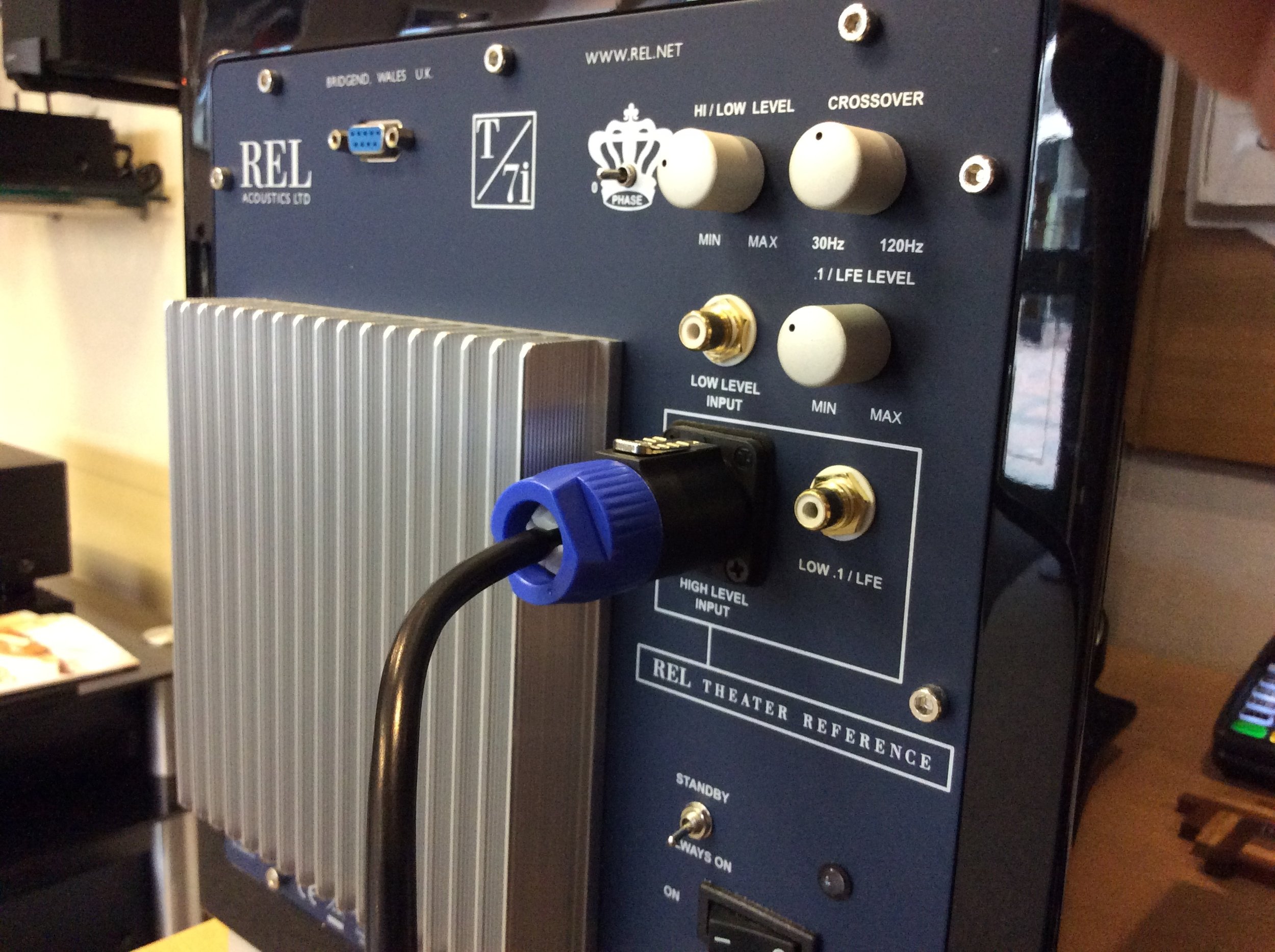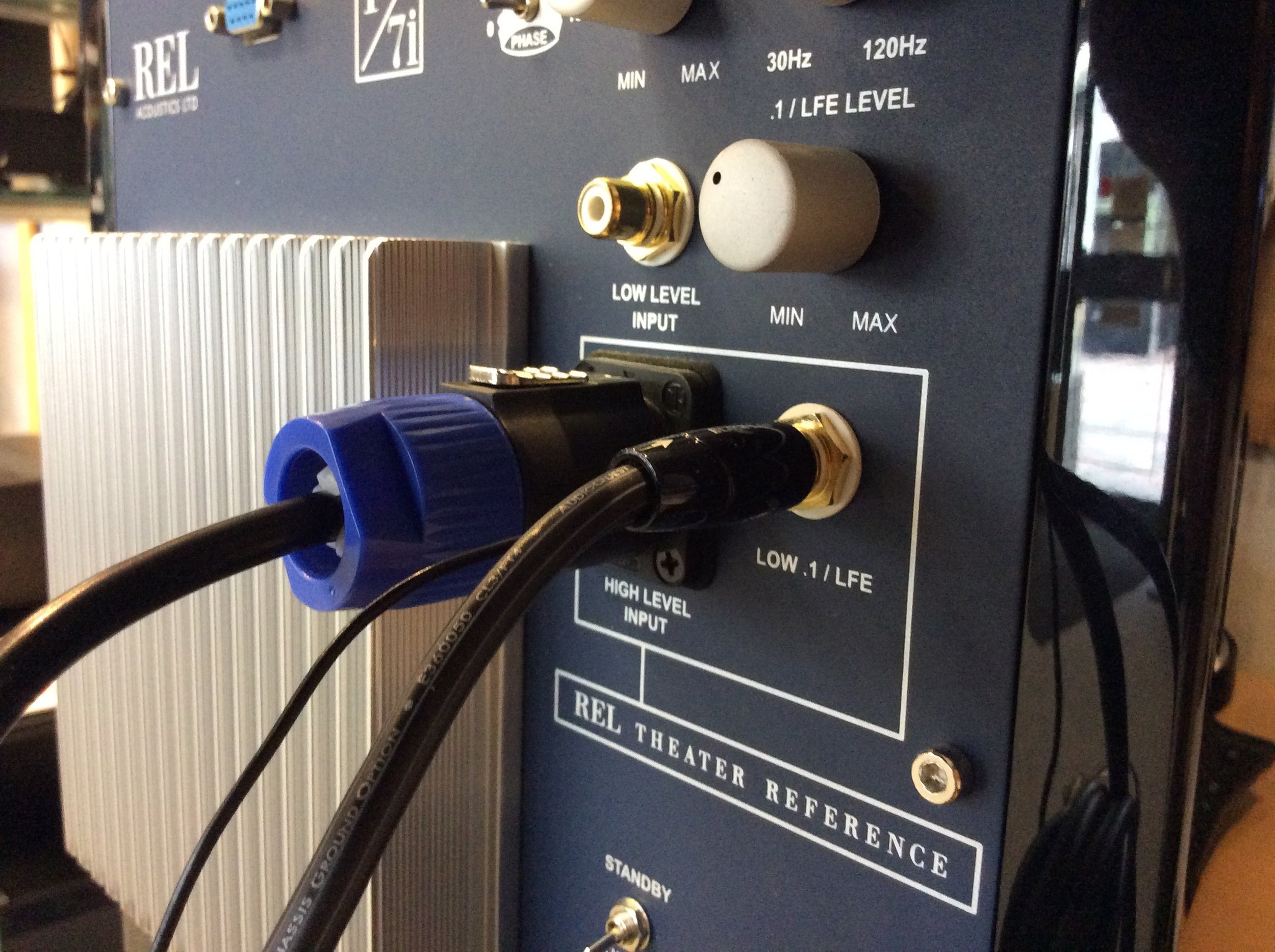When Bass Fights Vinyl: Subwoofers and Low-End Frequencies within Turntable Systems
/Sometimes in Hi-Fi, fixing one problem reveals another.
On a recent install, a customer loved everything about their home cinema system—except one thing: it lacked that low-end punch during movie night. Music sounded fantastic thanks to a REL S3 running in High-Level mode, but LFE (Low Frequency Effects) for cinema simply didn’t hit hard enough.
We introduced the REL S/510 to the system, and it did exactly what it says on the tin: more depth, more presence, more theatre. The customer was thrilled.
Until the vinyl came out…
When Vinyl Says “No Thanks”
Once we turned up the volume for some vinyl playback, a low-end hum started creeping in—the kind that doesn’t belong on any record. It wasn’t present with the previous sub and only revealed itself when things got loud. After ruling out the usual suspects (grounding hum, dodgy cables), we tried using a Bassline Blue cable dedicated for Naim systems, as well as running the signal directly from the speakers.
The issue was still there.
What we were hearing wasn’t electrical—it was physical.
Vibration Wars: Stylus vs. Low-End
At a certain point, the subwoofer was feeding so much energy into the room that the vibrations found their way into the turntable cartridge. It was a feedback loop: the stylus picked up a vibration, the signal got amplified, the subwoofer output it again, the stylus picked up even more. The result? A runaway low-frequency rumble that only stopped when we backed off the volume.
What Was Actually Happening?
The cause of the issue can be broken down into two distinct types of feedback, both of which were likely contributing to the problem:
1. Airborne Acoustic Feedback
Also known as acoustic coupling, this happens when powerful low-frequency sound waves travel through the air and cause the cartridge and stylus to resonate. The stylus acts like a microphone, picking up these waves and creating a feedback loop. This is especially common at higher volumes or when the turntable is exposed and close to a sub. In powerful subs like the REL S/510 (or in some large floorstanding speakers) that move a lot of air, especially below 30Hz, the low-end energy isn’t just felt in your chest—it can also be picked up by the stylus, causing unwanted output.
2. Structure-Borne Feedback
This type of resonance—often called mechanical or structural feedback—occurs when low-frequency energy from the sub travels through the floor or furniture into the turntable’s chassis or plinth. These vibrations don’t travel through the air; they move through solid material. Once they reach the tonearm and stylus, they’re amplified just like a music signal would be. This is particularly problematic with wooden floors, shared furniture, and lightweight plinths.
Both forms of feedback create the same result: an unpleasant, often deep rumble or hum, especially audible during quiet passages. The key difference is how the unwanted vibration gets to the stylus—through the air, or through the structure.
The Troubleshooting Begins
The first thing we tried was closing the lid on the customer’s Planar 3 to reduce airborne feedback. While this made a marginal improvement, the rumble still reared its head as the volume climbed. We then repositioned the turntable, moving it as far from the subwoofer and walls as the short phono cable allowed, avoiding corners and potential room nodes (areas where bass naturally builds up due to reflections). We also adjusted the toe-in of the subwoofer to redirect energy. Still, the problem persisted.
Without any accessories to hand, I asked to borrow the customer’s wife’s yoga mat. Understandably, this raised eyebrows—but I wasn’t planning on doing stretches. I placed it underneath the subwoofer as a makeshift damping layer to absorb energy being transmitted into the floorboards. While not a REL-approved method (and only to be used in specific cases), it was surprisingly effective: we gained around 20% more volume before the feedback returned.
That confirmed it—structure-borne vibration was a significant part of the issue.
Back to Base: A Few Calls and Some Controlled Testing
Back at the shop, I made a few calls and did some research. The consensus was clear: try wall-mounting the turntable, or upgrade to a heavier, better-isolated deck. High-mass or suspended designs tend to fare better against structural vibrations.
This led us to test the Rega Planar 3, 6, and 8 in-store. With headphones connected, we gently tapped each plinth and the surface it sat on. The difference was immediate. The Planar 3 amplified the knocks into clearly audible thuds—hollow and easily disturbed. The Planar 6 was more restrained. The Planar 8? Practically silent. The resonance was absorbed, the structure more inert—a clear win for the P8’s improved isolation feet and build.
The Return Visit: P8, Pucks, and a Filtered Fix
Armed with better gear, I returned with a Planar 8, IsoAcoustics pucks, a Zazen isolation platform, and a phono stage with a subsonic filter.
We started with the filter, which helped roll off ultra-low frequencies that aren’t musically useful but can still wreak havoc with a powerful subwoofer. This gave the sub more breathing room and allowed a few extra decibels before the loop began.
The Planar 8 also made a meaningful difference—not just in terms of vibration resistance (not night and day, but enough), but musically, the improvement was immediate and appreciated by the customer.
Still, despite these upgrades, loud, bass-heavy tracks could still push the system into a feedback loop at higher volumes. It was better, but not bulletproof.
One Last Trick and the Real Culprit Emerges
We decided to try one last test, moving the turntable to the far side of the room onto a drinks cabinet with its own isolation platform, away from shared furniture, subwoofer air pressure, and wall reflections. Sadly, the issue still crept in at higher volumes.
At this point, we were confident that structure-borne feedback had been addressed. We had used a better turntable, isolated it physically, and moved it well away from the subwoofer’s direct influence. Still, something was missing.
As a last-ditch effort, we placed a cardboard box over the Planar 8 and topped it with a thick blanket.
And… Voila.
THE Temporary, NOT-SO SOPHISTICATED TURNTABLE COVER
That did it! Whilst looking comical, it gave us the answer we were looking for.
We could finally crank up the volume—with deep, powerful bass—and the loop didn’t return. Not the prettiest solution, but incredibly effective. The thicker materials created a protective bubble, dampening the low-end pressure waves before they reached the stylus. The standard lid on the Planar 3 had made only a very small difference. Now we knew why.
With this information, the customer was able to order a bespoke acrylic cover that would be a bit thicker than standard. At last, we were able to play vinyl at loud volumes with the much-improved S/510, whilst getting the desired home cinema effect he was after when he initially contacted us.
A Final Note on System Balance
It’s worth noting: the issue never became apparent with the smaller REL S3. It simply didn’t reach as low or move as much air at normal listening volumes. However, upon further testing and pushing the system a bit harder, the loop began to creep in with the S3 too—it just took a lot more input to get there.
That’s the paradox here: the better your bass system, the more revealing—and potentially problematic—it can be. And while this story focused on a subwoofer, the same issue can arise with full-range floorstanding speakers, especially those capable of digging below the 30Hz range.
If you’re considering upgrading your speakers or adding a subwoofer into a system that includes vinyl playback—or you’re already experiencing mysterious low-end hum or feedback—some of the approaches above may help. That said, every setup is different. The combination of turntable, subwoofer, room acoustics, and even the construction of your home all play a part. It often comes down to trial and error to find what works best in your specific environment, and we’re always happy to help troubleshoot—whether that’s in-store or on-site.
Below is a summary of the solutions discussed:
Structure-Borne Feedback Solutions
• Move the turntable away from subwoofers or floorstanders
• Add weight to the surface the turntable sits on for added stability
• Wall-mount the turntable to decouple it from floor vibrations
• Use a phono stage with a subsonic filter
• Use a dedicated isolation platform or Rack on the turntable
• Add decoupling pucks or feet under the turntable
• Use a high-mass or better-isolated turntable
• Avoid placing the turntable on shared AV racks or lightweight furniture
• Add damping beneath the subwoofer (heavy plinth or dedicated platforms) in emergencies)
• Use suspended turntable designs for built-in isolation (where possible)
Airborne Acoustic Feedback Solutions
• Use the turntable lid
• Cover the turntable with a heavier enclosure
• Position the turntable away from the subwoofer and speaker output paths
• Place the turntable behind furniture or acoustic barriers
• Use a phono stage with a subsonic filter
• Apply room treatment (e.g. bass traps, absorptive panels) near the turntable
• Toe-in or reorient the subwoofer to redirect air pressure away from the turntable
Thanks for reading – Dan, Gareth & Rishi – Audio T Reading
If you have any questions about any of the equipment featured in this article, or any other Hi-Fi or home cinema enquiries, be sure to Contact Us.
If you’ve enjoyed this, why not go ahead and read more of our other blogs, and be sure to follow us on our social media channels below…
For any subwoofer, turntable or general audio related queries contact your local Audio T store -





















